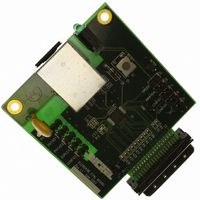KSZ8041NL-EVAL Micrel Inc, KSZ8041NL-EVAL Datasheet - Page 21

KSZ8041NL-EVAL
Manufacturer Part Number
KSZ8041NL-EVAL
Description
BOARD EVALUATION FOR KSZ8041NL
Manufacturer
Micrel Inc
Specifications of KSZ8041NL-EVAL
Main Purpose
Interface, Ethernet PHY
Embedded
No
Utilized Ic / Part
KSZ8041NL
Primary Attributes
Single Chip PHY, 10BASE-T/100BASE-TX
Secondary Attributes
MII, RMII, HP Auto MDI, MDI-X Auto Polarity Correction
Lead Free Status / RoHS Status
Lead free / RoHS Compliant
Other names
576-1621
Micrel, Inc.
10Base-T Receive
On the receive side, input buffer and level detecting squelch circuits are employed. A differential input receiver circuit and
a PLL performs the decoding function. The Manchester-encoded data stream is separated into clock signal and NRZ data.
A squelch circuit rejects signals with levels less than 400 mV or with short pulse widths to prevent noise at the RX+ and
RX- inputs from falsely trigger the decoder. When the input exceeds the squelch limit, the PLL locks onto the incoming
signal and the KSZ8041NL/RNL decodes a data frame. The receive clock is kept active during idle periods in between
data reception.
SQE and Jabber Function (10Base-T only)
In 10Base-T operation, a short pulse is put out on the COL pin after each frame is transmitted. This SQE Test is required
as a test of the 10Base-T transmit/receive path. If transmit enable (TXEN) is high for more than 20 ms (jabbering), the
10Base-T transmitter is disabled and COL is asserted high. If TXEN is then driven low for more than 250 ms, the 10Base-
T transmitter is re-enabled and COL is de-asserted (returns to low).
Auto-Negotiation
The KSZ8041NL/RNL conforms to the auto-negotiation protocol, defined in Clause 28 of the IEEE 802.3u specification.
Auto-negotiation is enabled by either hardware pin strapping (pin 30) or software (register 0h bit 12).
Auto-negotiation allows unshielded twisted pair (UTP) link partners to select the highest common mode of operation. Link
partners advertise their capabilities to each other, and then compare their own capabilities with those they received from
their link partners. The highest speed and duplex setting that is common to the two link partners is selected as the mode
of operation.
The following list shows the speed and duplex operation mode from highest to lowest.
If auto-negotiation is not supported or the KSZ8041NL/RNL link partner is forced to bypass auto-negotiation, the
KSZ8041NL/RNL sets its operating mode by observing the signal at its receiver. This is known as parallel detection, and
allows the KSZ8041NL/RNL to establish link by listening for a fixed signal protocol in the absence of auto-negotiation
advertisement protocol.
The auto-negotiation link up process is shown in the flow chart illustrated as Figure 1.
September 2010
•
•
•
•
Priority 1: 100Base-TX, full-duplex
Priority 2: 100Base-TX, half-duplex
Priority 3: 10Base-T, full-duplex
Priority 4: 10Base-T, half-duplex
21
M9999-090910-1.4
KSZ8041NL/RNL













